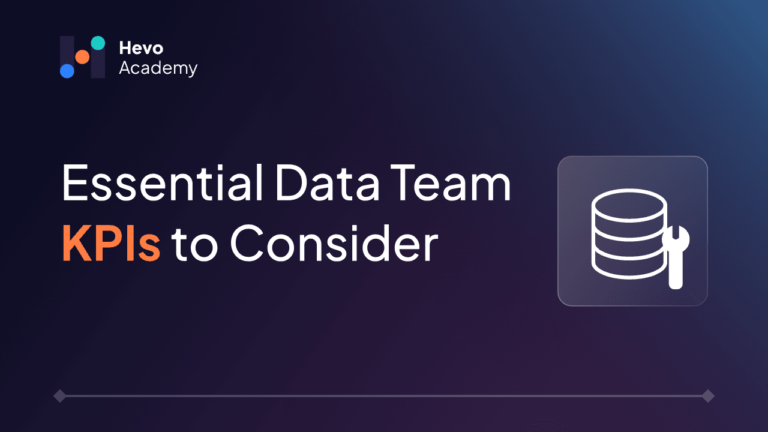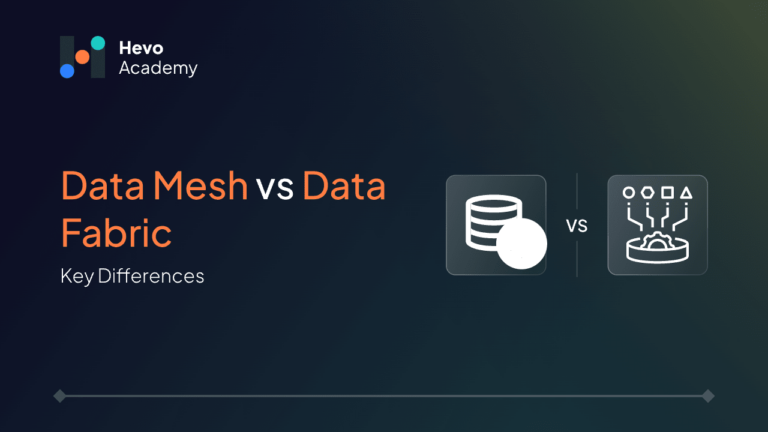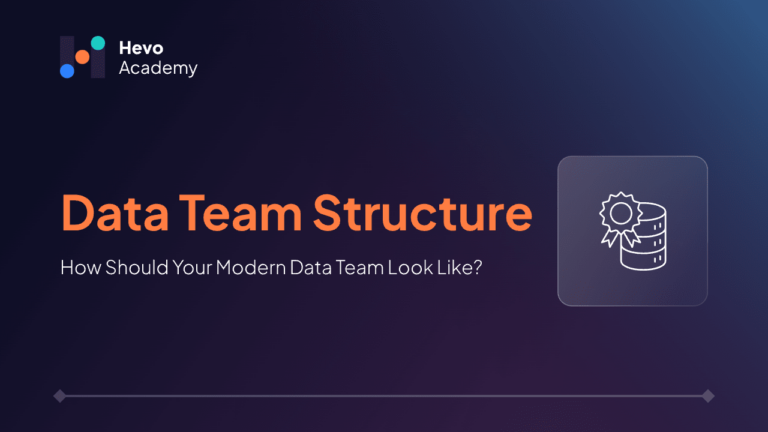When we discussed data in the early days of computing, our primary focus was only storage and retrieval. Metadata was documented manually in separate files or physical copies of the document. The world of data technology has switched from storing data on a monolithic data storage to more sophisticated Data Lake, Warehouse, and Lakehouse solutions for business intelligence needs. They are built by consolidating data from disparate sources and thus arises a need for a central metastore, a data catalog to describe accessibility, discoverability, data lineage, transformations, and business rules.
Table of Contents
Thus, managing metadata is crucial for any data-driven organization. In this blog, we will discuss metadata management in AWS and how we can leverage services like Glue data catalog, S3 object tag, Lake formation, etc., for metadata management and centralized governance.
What is Metadata Management?
Metadata is defined as data of data. Metadata management is a process of collecting, organizing, and maintaining data about data in a metastore. It involves using tools and technologies designed to manage metadata extensively throughout its lifecycle, from creation to storage, distribution, usage, and retirement.
Objectives of Metadata Management
The primary objective of metadata management is to ensure that the data is:
- Easily discoverable for users across departments and verticals of an organization, and find relevant data quickly.
- End users can understand the context, structure, and lineage of the data acquired.
- Data is accessible only to authorized users or applications.
- Contribute to data’s reliability, consistency, and accuracy, making it trustworthy.
- Enforce governance for regulatory, security, and privacy requirements of the organization.
Hevo Data is the leading no-code platform that empowers you to manage metadata seamlessly across your AWS environment. With Hevo, you can:
- Consolidate metadata from 150+ sources
- Automatically map and organize your data assets
- Enable in-flight metadata transformation
Keep your AWS metadata accurate and up-to-date with Hevo’s intuitive data integration capabilities. Start your 14-day free trial today and unlock the full potential of your data in AWS.
Get Started with Hevo for FreeMetadata Management in AWS: Overview & Services
AWS offers numerous services that enterprises use for metadata management within their organization. Let us discuss some of them in detail:
1. AWS Glue Data Catalog
AWS Glue Data Catalog is a fully managed metadata repository. It is a part of the AWS Glue family of services, which is a managed Extract Transform Load (ETL) service. The Glue Data Catalog is designed to serve as a centralized metastore for all of the organization’s data assets within or outside AWS, making it easier to discover, organize, and manage data.
Key Features of Glue Data Catalog
- Centralized Metadata Repository:
- A centralized metadata repository for data stored in various AWS services such as Amazon S3, Redshift, RDS, and DynamoDB.
- Define and manage table and schema definitions, partitions, and other metadata for the data assets.
- Automatic Schema Discovery:
- AWS Glue Crawler helps discover and catalog metadata from different data sources automatically.
- It traverses the data store it is pointed to and extracts schema-related information, such as table structure, column types, etc. and stores it in a data catalog.
- Schema Versioning and Evolution:
- Helps track changes in data schemas over time and supports schema versioning and evolution.
- Partitioning and Indexing:
- Glue data catalogs support and track partition information. This further helps query performance by allowing the storage of large data in manageable small partitions.
- Supports indexing metadata, that enables faster data discovery and access.
- Integration with AWS Analytics Services:
- It natively supports integration with various AWS analytics services such as Amazon Athena, Redshift, Redshift Spectrum, and Elastic Map Reduce (EMR).
- Act as a metadata layer for these services to query over the data stored in Amazon S3.
- Data Security and Access Control:
- It is integrated with AWS Identity and Access Management (IAM) to provide fine-grained, managed central access control.
- Search and Discovery:
- It provides a searchable metadata repository, which allows users to easily find datasets based on various criteria such as table names, columns, data types, etc.
- Supports tags and annotations to add business context and descriptive metadata to data assets.
2. AWS S3 Object Tags
AWS S3 is an object storage service. It is primarily used as a data lake for any organization as it provides infinite storage and is designed to exceed 99.999999999% (11 nines) data durability. However, accumulating all the data in an S3 location can be confusing, and losing track of data would be the least of our concerns.
This is where S3 object tags come in handy. It is a powerful feature for managing and classifying data in the S3 buckets. Tags are key-value pairs associated with S3 objects to store metadata beyond default configurations. Let us discuss some examples to see the S3 object tag in action:
- Organizing and Categorizing Data
- Classification: Tags can be used to classify objects based on project, department, sensitivity, etc. Examples of tag objects are Project: A Confidentiality: High.
- Filtering and Searching: We can assign tags to filter and search for objects inside the S3 management console. This comes in very handy if one is dealing with a large dataset. For example, you might want to find all objects with the tag Environment: Production, which will bring up all the production data.
- Access Control
- Tag-Based IAM Policies: We can apply IAM policies to S3 Object tags to enable tag-based access control for the objects. For example, we might create an IAM policy allowing users to view only those objects tagged with the Department: Finance key-value pair.
- Bucket Policies: Similar to bucket policies, we can leverage bucket policies to ensure we apply tag-based access control, adding security and compliance.
- Lifecycle Management
- Automated Actions: S3 object lifecycle policies that use tags to define various actions can be determined. These include object transitions from one storage class to another, archiving, or permanent deletion after a certain period. For example, objects tagged with Archive: True could be transitioned to S3 Glacier after 30 days.
- Cost Management: Object tags enable better planning of the object’s lifecycle and, hence, better planning and management of the cost of storing these objects.
- Compliance and Reporting
- Audit and Compliance: It enables tagging to track data for compliance purposes. Example: Tagging objects with Retention: 2024 facilitates the identification of the data that should be retained or audited in a particular year.
- Custom Reports: When creating custom reports, specifically metadata-based reports, one can leverage tags to identify all objects that pertain to a certain project or department for auditing or review purposes.
- Data Management and Governance
- Data Ownership: Tags such as Owner: JohnDoe make it easier to identify who is responsible for particular data.
- Data Quality: Tags such as Status: Reviewed or Quality: High enable better data quality management across your organization.
3. AWS Lake Formation
AWS Lake Formation is a fully managed centralized service that enables users to create, manage, and govern data lakes on AWS. It is built on the top of AWS Glue and enhances its capabilities, providing a robust solution for managing metadata, data access, and data governance in a data lake environment. Wonder what role AWS Lake Formation plays in managing metadata and simplifying data access control and cataloging? Let us discuss this in brief.
Role in Managing Metadata within a Data Lake
- AWS Lake Formation extends the capabilities of the AWS Glue Data Catalog. It provides a unified view of the metadata for data stored in various sources, including but not limited to Amazon S3, Redshift, and other data stores.
- Centralizes metadata management across the organization’s multiple data lakes and ensures consistent and accurate metadata management across data lakes.
- Natively integrates with Glue Crawlers to provide automatic schema discovery.
- It supports schema evolution and versioning, keeping track of the latest versions and retiring older ones.
- It provides blueprints and templates, including best practices for metadata management, to help create a well-organized and efficient data lake environment.
How It Simplifies Data Access Control and Cataloging
- AWS Lake Formation centralizes cataloging along with data access control.
- It lets you define and centrally manage fine-grained access control policies.
- It helps you define minutely crafted policies to allow row level, column level to table, and database level access permission.
- Column-level and row-level security helps restrict access to sensitive data within specific columns or rows based on user roles and permissions.
- It complements the Glue data catalog with a feature that helps track data lineage and auditing access.
- Helps monitor data usage and maintain data compliance and governance policies.
- Natively integrates with services like Amazon Athena, Redshift, Redshift Spectrum, Glue, Quicksight, etc. For example, we can set up policies to control who can query data with Amazon Athena, process data with AWS Glue, or analyze S3 data using Amazon Redshift Spectrum.
- Powers a self-service model of data platform. Simplifies data sharing enhances collaboration and accelerates data-driven decisions.
- It integrates with AWS KMS to encrypt data at rest and in transit, ensuring the security and protection of sensitive data.
4. AWS RDS and Aurora
AWS RDS(Relational Database Service) and Aurora are managed database services that offer a MySQL and PostgreSQL-compatible relational database engine. Since they are managed services, they have a very robust mechanism for managing metadata within the database engine and use information schema to handle metadata.
Information Schema
The information schema represents a set of system tables provided by relational databases, offering metadata regarding the objects of the database. It stores information on schemas, tables, columns, constraints, indexes, and other database objects.
It has SQL-compliant queries and makes querying metadata within various relational databases easy.
- Information about tables, views, and columns of databases can be fetched. For example INFORMATION_SCHEMA.TABLES can be queried to fetch information on all the tables of a database.
- INFORMATION_SCHEMA.TABLE_CONSTRAINTS is used to fetch details about primary keys, foreign keys, and unique constraints.
- INFORMATION_SCHEMA.COLUMNS is used to fetch information about a column’s data type, default value, and nullability.
Let us look at some sample queries.
List all tables in a database:
SELECT * FROM INFORMATION_SCHEMA.TABLES WHERE TABLE_SCHEMA = 'your_database';Get details about the columns of a particular table:
SELECT COLUMN_NAME, DATA_TYPE, IS_NULLABLE
FROM INFORMATION_SCHEMA.COLUMNS
WHERE TABLE_NAME = 'your_table';5. AWS Data Exchange
AWS Data Exchange is a service that lets us subscribe to and use third-party data in AWS Cloud. It simplifies the entire process of subscribing to, licensing, delivering, and updating third-party data.
Managing Metadata for Third-Party Datasets
AWS Data Exchange manages metadata for different data providers to facilitate swift data discovery, governance, and usage.
- Every available dataset includes detailed metadata, such as description, data formats, schema, update frequency, etc., which helps subscribers understand the content of the data before subscribing.
- Individual assets of the datasets also have metadata associated with them. This includes information like data type, size, creation date, etc.
- AWS Data Exchange manages different versions of datasets with respective metadata for each. Publishers and subscribers can work with multiple versions of the same dataset.
- Data Exchange can also deliver data directly to an S3 bucket. We can integrate the metadata with the AWS Glue data catalog to leverage its full potential, such as schema inference, transformation, etc.
How does AWS Data Exchange help in Data Discovery and Governance?
- Rich metadata associated with datasets helps subscribers quickly search and discover data that fits their needs in the centralized marketplace of AWS Data Exchange.
- Access control and compliance are managed through a subscription model which includes data usage policies and legal requirements.
Hive Metastore vs AWS Glue comparison
Hive Metastore and AWS Glue Data Catalog are two popular metadata management tools. Let’s look at the head-on comparison of both.
| Feature | Hive Metastore | AWS Glue Data Catalog |
| Use Case | Metadata management for hive and Hadoop ecosystem. | Unified metadata catalog for AWS Data sources and ETL jobs. |
| Deployment | On-prem, self-managed Hadoop cluster. | Fully managed by AWS |
| Serverless | Need to manage underlying servers on our own. | Serverless, AWS manages all the underlying infrastructure. |
| Integration | Integrates with Apache Spark, HBase, etc. | Integrates with AWS Services like S3, Redshift, Glue, etc. |
| Scalability | Requires manual scalability management. | Automatically scales as per usage. |
| Data Source Support | Primarily supports Hadoop ecosystem (HDFS, Hive, etc.) | Broad support for AWS and external data sources using Glue crawlers |
| Schema Evolution | Supports schema evolution | Supports schema evolution and updates. |
| Cost | Fixed cost depending on underlying infrastructure | Pay-as-you-go pricing model |
| Customization | Highly customizable as per our requirements. | Customization is limited within the AWS environment. |
| Data Cataloging | Basic metadata management and schema storage | Rich metadata management, including data lineage and ETL job tracking |
| Data Discovery | Manual setup and requires additional tools. | In-built data discovery feature. |
| Data Lineage | Requires additional tools and manual effort. | In-built feature |
| Data Transformation | Focused on metadata management. | Supports Glue integration for ETL jobs. |
Conclusion
Thus, we can conclude that metadata management is a very critical component of any data-driven organization for data accessibility, discoverability, and governance. AWS offers a range of robust services like Glue Data Catalog, S3 Object Tags, Lake Formation, and RDS/Aurora to manage metadata across diverse data sources efficiently.
These tools provide centralized control, enhance data security, and support compliance, making AWS a powerful platform for managing diverse metadata types in today’s complex data environments. Leveraging these AWS services can greatly enhance data management and governance capabilities, driving more informed and strategic decision-making.
Schedule a personalized demo with Hevo for seamless data integration.
Frequently Asked Questions (FAQs)
1. How does AWS Glue Data Catalog differ from AWS Glue?
Glue is a family of services, whereas AWS Glue is an ETL service and the Data Catalog stores metadata.
2. Can AWS Glue Data Catalog connect to my on-premises databases?
Yes, you can connect AWS Glue Data Catalog to on-premises databases using AWS Glue Crawlers and connections.
3. How do I query data stored in the AWS Glue Data Catalog?
To query data in the AWS Glue Data Catalog, you can use Amazon Athena, Redshift Spectrum, or AWS Glue ETL jobs.
4. Can I modify the schema of a table in the AWS Glue Data Catalog?
You can modify the schema manually or by re-running the Glue Crawler.
5. What services can integrate with AWS Glue Data Catalog?
It supports native integration with AWS services like Athena, Redshift Spectrum, EMR, QuickSight, and SageMaker.
6. Is AWS Glue Data Catalog compatible with Apache Hive?
Yes, it can replace Hive Metastore for metadata management.
7. How do I improve the performance of my AWS Glue Data Catalog queries?
To improve performance optimize partitioning, use compression, and update metadata regularly.






